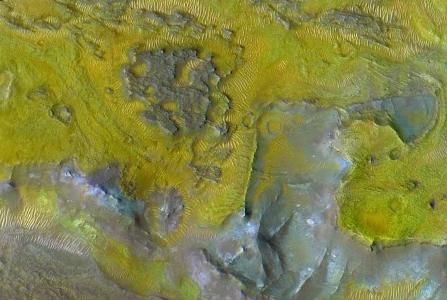More evidence of water on Mars
US scientists have discovered many large carbonate mineral salts in the rock seams on Mars. This proves that the red planet once had a lot of water.

Photograph of carbonate (bright green) area in Nili Fossae region on Mars.Photo: NASA.
A group of experts from Brown University, Rhode Island, USA used a high-resolution spectrum analyzer on board the probe of NASA's Mars Reconnaissance Orbiter to search for minerals on the red planet. They found a giant magnesium carbonate (MgCO 3 ) mine dating back 3.6 billion years in rock formations on a volcano. In addition, the research team also found carbonate salts in some other places.
Carbonate salts form when water and CO2 interact with calcium (Ca), iron (Fe) or magnesium (Mg). They dissolve very quickly in acid, so the new finding negates the hypothesis that the water on Mars is acidic. Instead, the country involved in carbonate reaction must have a neutral pH (pure or alkaline).
"Neutral pH can be a suitable environment for life and biological activities to form. Maybe underground water circuits or Martian surface lakes used to be water supplies," Bethany Ehlmann, research leader, commented.
Scientists have found microorganisms in some forms of carbonate salt on the earth, such as chalk and limestone, but they have not done the same thing on Mars. In 2004, NASA's Opportunity probe detected sulphate and iron-rich minerals on Mars. At that time, it was thought that carbonate that could not form in the acidic environment of the oceans once existed on the red planet.
A 2006 study showed that Mars once had a denser atmosphere and more neutral pH sources. But then the activity of thousands of volcanoes causes the atmosphere and the surface of the red planet to be dominated by acids. Researchers say it is possible that a large amount of carbonate salt is being buried underground or lava on Mars.
- Evidence of water once flowing on Mars
- Find evidence of groundwater around Mars?
- Add evidence of water on Mars
- Found evidence of water covering the whole of Mars
- NASA: New evidence of water on Mars
- Detecting signs of water flowing on Mars
- Water freezes right under the surface of Mars
- There was drinking water on Mars
- Evidence of widespread water in Mars
- Water flows on Mars - the discovery changes the cosmic perception
- Mars: adding new evidence for the existence of water
- The photos prove there is water flowing on Mars
 Van Allen's belt and evidence that the Apollo 11 mission to the Moon was myth
Van Allen's belt and evidence that the Apollo 11 mission to the Moon was myth The levels of civilization in the universe (Kardashev scale)
The levels of civilization in the universe (Kardashev scale) Today Mars, the sun and the Earth are aligned
Today Mars, the sun and the Earth are aligned The Amazon owner announced a secret plan to build a space base for thousands of people
The Amazon owner announced a secret plan to build a space base for thousands of people